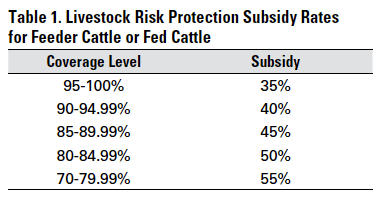Proactive Security: Bagley Risk Management Tactics
Proactive Security: Bagley Risk Management Tactics
Blog Article
Trick Factors to Consider When Picking Livestock Threat Security (LRP) Insurance Policy
When reviewing alternatives for Animals Risk Protection (LRP) insurance, a number of key variables warrant careful factor to consider to make sure efficient danger monitoring in the farming industry. Choosing the appropriate insurance coverage choices tailored to your details animals operation is vital, as is understanding just how exceptional costs associate with the level of defense supplied.
Protection Options
When taking into consideration Animals Risk Protection (LRP) insurance, it is crucial to comprehend the numerous coverage choices available to minimize threats in the farming industry. Animals Threat Defense (LRP) insurance policy offers various coverage choices customized to satisfy the diverse requirements of animals manufacturers.
An additional essential coverage alternative is the endorsement duration, which figures out the length of time the protection holds. Manufacturers can choose the endorsement period that ideal suits their manufacturing cycle and market problems. Additionally, insurance coverage levels and prices vary based upon the kind of animals being guaranteed, offering manufacturers the versatility to personalize their insurance coverage plans according to their particular demands.
Comprehending the different insurance coverage options offered under Animals Risk Security (LRP) insurance coverage is essential for manufacturers to make enlightened choices that effectively protect their animals operations from market unpredictabilities.
Premium Costs

Livestock Risk Security (LRP) insurance coverage offers vital protection choices tailored to reduce risks in the farming market, with a considerable aspect to think about being the calculation and structure of premium costs. When identifying premium costs for LRP insurance, several factors enter play. These consist of the type and variety of animals being guaranteed, the coverage degree selected, the existing market prices, historical price data, and the length of the coverage duration. Insurance companies might additionally take into consideration the place of the ranch, as geographical variables can influence the general danger profile.
Insurance companies examine historical data on livestock rates and production prices to identify an appropriate costs that reflects the degree of risk involved. It is crucial for animals manufacturers to meticulously review premium costs and coverage options to ensure they are adequately shielded against possible economic losses due to adverse market problems or unforeseen occasions.
Qualified Livestock
The decision of eligible animals for Animals Danger Security (LRP) insurance coverage entails cautious factor to consider of certain requirements and qualities. Livestock types that are usually qualified for LRP insurance coverage include feeder cattle, fed swine, lambs, and livestock.
Feeder cattle, for example, are generally eligible for LRP insurance coverage if they fall within specified weight arrays. Lambs are one more classification of livestock that can be considered for LRP insurance policy, with elements such as weight and age playing an essential duty in determining their eligibility.
Before choosing LRP insurance for animals, producers ought to meticulously review the eligibility requirements laid out by the insurance company to guarantee their pets fulfill the needed this requirements for insurance coverage.
Policy Flexibility
Policy flexibility in Livestock Danger Security (LRP) insurance coverage allows producers to tailor coverage to match their details needs and run the risk of management methods. This flexibility encourages animals manufacturers to tailor their insurance policy plans based on aspects such as the type of livestock they own, market conditions, and individual danger resistance degrees. By using adjustable choices, LRP insurance enables manufacturers to effectively manage their risk direct exposure while securing their animals operations against unexpected market volatility.
Claims Refine
Upon experiencing a loss or damage, manufacturers can launch the cases process for their Livestock Risk Protection (LRP) insurance coverage by promptly calling their insurance coverage company. It is crucial for manufacturers to report the loss immediately to quicken the cases process. When connecting to the insurance policy provider, producers will certainly need to supply in-depth details about the incident, consisting of the day, nature of the loss, and any kind of appropriate paperwork such as veterinary documents or market prices.

After the evaluation is full, the insurance coverage provider will choose concerning the case and communicate the end result to the manufacturer. The producer will advice certainly receive settlement according to the terms of their Livestock Danger Defense (LRP) insurance policy if the case is approved. It is crucial for manufacturers to be knowledgeable about the insurance claims process to make certain a smooth experience in the event of a loss

Final Thought
Finally, when choosing Animals Threat Protection (LRP) insurance, it is important to consider coverage options, premium prices, qualified livestock, policy versatility, and the claims process. These key factors will aid make certain that farmers and herdsmans are sufficiently safeguarded against potential threats and losses connected with their livestock procedures. Making a notified decision based upon these factors to consider can eventually lead to better monetary safety and satisfaction for livestock manufacturers.
Livestock Risk Defense (LRP) insurance coverage provides my website various coverage choices tailored to fulfill the varied requirements of livestock manufacturers.The decision of eligible livestock for Animals Danger Protection (LRP) insurance policy coverage involves mindful consideration of specific standards and attributes.Plan flexibility in Animals Danger Defense (LRP) insurance coverage permits producers to customize protection to fit their specific demands and run the risk of management methods.Upon experiencing a loss or damage, producers can start the claims procedure for their Livestock Threat Security (LRP) insurance policy by quickly calling their insurance service provider.In conclusion, when picking Livestock Threat Protection (LRP) insurance policy, it is necessary to consider protection options, premium prices, eligible animals, plan flexibility, and the cases procedure.
Report this page